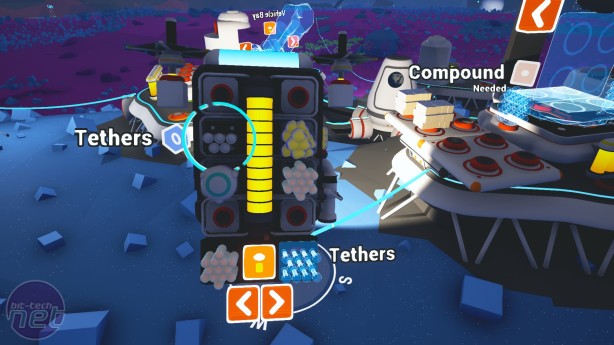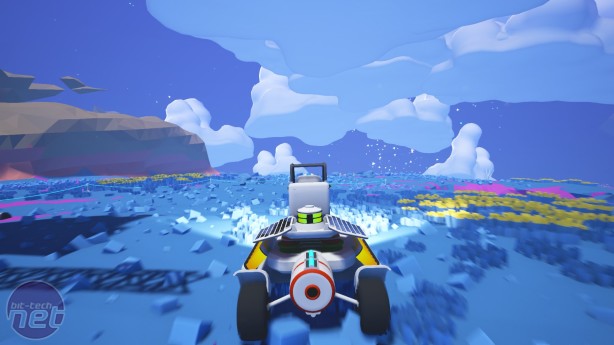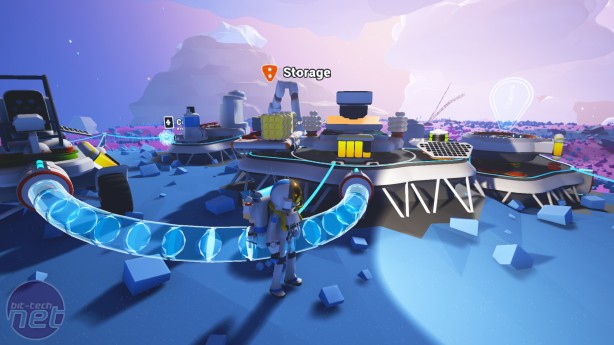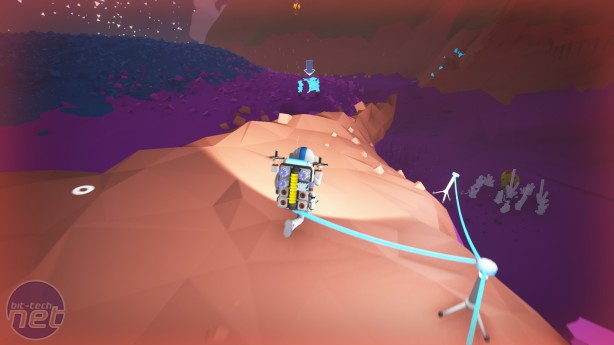
Obviously, this makes exploring an entire planet a bit tricky. But collect a little Compound, and your Astroneer can craft a bunch of tethers and use them to increase the length of his O2 line. Not only does this lend the act of exploration physical feedback, it also provides a visual overview of your pioneering achievements. With each new tether you plant into the ground, the planet is gradually wrapped in your spindly, neon-blue threads.
Even the act of base construction, which is the aspect of these games that I find least appealing, is made simple and satisfying thanks to the way buildings and objects snap neatly into place. Each building comes with LEGO-like nodules on either side of it to which you can connect a number of auxiliary structures. These include storage pads, solar panels, wind turbines, and so forth. What’s more, so long as your base is connected together, any power supply you plug into one module will supply that power to the entire base.
The attention that System Era Softworks pays to the little things in Astroneer makes it a very promising prospect for the future. But I wouldn’t encourage you to make a purchase just yet. Astroneer is still in very early Alpha, and consequently there are a lot of features either missing or incomplete. Exploration currently yields little reward aside from discovering new resources. There are no living creatures in the game, and the planets in general are lacking in variety and weirdness.
In addition, base construction currently only allows for five or six different buildings in total. You can discover a few extra modules by retrieving research pods while exploring, but these don’t offer a massive amount extra to the game. Meanwhile, some of the things you can build in-game don’t function as well as they should, the main one being vehicles. I was thrilled when I constructed my solar-powered moon-buggy, but its handling made Mass Effect’s Mako look like a Formula 1 car by comparison.
The terrain deformation is another feature that hints at greatness without having a huge amount of practical implementations. It’s a fantastic aid to exploration, as if you fall down a cliff or need to reach a high ledge, you can just build yourself a ramp in a couple of minutes. Also, if you’re ambitious enough, you can do some crazy things with it like build a giant column that reaches into space. But currently, there aren’t many reasons to utilise it for larger building projects or other applications such as defensive earthworks.
All of these things are to be expected in an Early Access game, and I have no doubt most if not all will eventually be remedied. But I also have one other concern. While I admire Astroneer for its little innovations, I fear that it is lacking one big idea to make it stand out. If you asked me what kind of game Astroneer was, I would say something along the lines of, 'It’s a little bit like Space Engineers, but it does X differently', rather than saying, 'It’s the game for that kind of experience.'
What’s there is cleverly designed, but I don’t think it does enough to stand out right now. A few people have proclaimed it to be what No Man’s Sky should have been, but I think such claims are premature, and No Man’s Sky has changed considerably since its release (something I’m hoping to explore later this year). One other thing that is worth mentioning is that Astroneer supports four-player co-op, which gives it an edge over quite a few games of this ilk. Again, though, it’s probably worth waiting until the game is more filled out before jumping in with a bunch of friends.
Even the act of base construction, which is the aspect of these games that I find least appealing, is made simple and satisfying thanks to the way buildings and objects snap neatly into place. Each building comes with LEGO-like nodules on either side of it to which you can connect a number of auxiliary structures. These include storage pads, solar panels, wind turbines, and so forth. What’s more, so long as your base is connected together, any power supply you plug into one module will supply that power to the entire base.
The attention that System Era Softworks pays to the little things in Astroneer makes it a very promising prospect for the future. But I wouldn’t encourage you to make a purchase just yet. Astroneer is still in very early Alpha, and consequently there are a lot of features either missing or incomplete. Exploration currently yields little reward aside from discovering new resources. There are no living creatures in the game, and the planets in general are lacking in variety and weirdness.
In addition, base construction currently only allows for five or six different buildings in total. You can discover a few extra modules by retrieving research pods while exploring, but these don’t offer a massive amount extra to the game. Meanwhile, some of the things you can build in-game don’t function as well as they should, the main one being vehicles. I was thrilled when I constructed my solar-powered moon-buggy, but its handling made Mass Effect’s Mako look like a Formula 1 car by comparison.
The terrain deformation is another feature that hints at greatness without having a huge amount of practical implementations. It’s a fantastic aid to exploration, as if you fall down a cliff or need to reach a high ledge, you can just build yourself a ramp in a couple of minutes. Also, if you’re ambitious enough, you can do some crazy things with it like build a giant column that reaches into space. But currently, there aren’t many reasons to utilise it for larger building projects or other applications such as defensive earthworks.
All of these things are to be expected in an Early Access game, and I have no doubt most if not all will eventually be remedied. But I also have one other concern. While I admire Astroneer for its little innovations, I fear that it is lacking one big idea to make it stand out. If you asked me what kind of game Astroneer was, I would say something along the lines of, 'It’s a little bit like Space Engineers, but it does X differently', rather than saying, 'It’s the game for that kind of experience.'
What’s there is cleverly designed, but I don’t think it does enough to stand out right now. A few people have proclaimed it to be what No Man’s Sky should have been, but I think such claims are premature, and No Man’s Sky has changed considerably since its release (something I’m hoping to explore later this year). One other thing that is worth mentioning is that Astroneer supports four-player co-op, which gives it an edge over quite a few games of this ilk. Again, though, it’s probably worth waiting until the game is more filled out before jumping in with a bunch of friends.

MSI MPG Velox 100R Chassis Review
October 14 2021 | 15:04













Want to comment? Please log in.